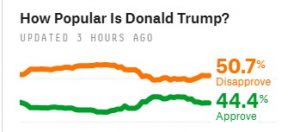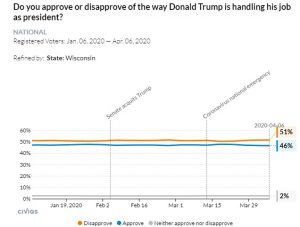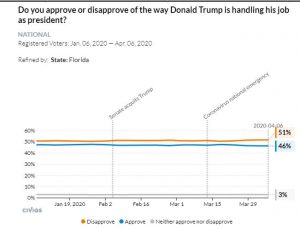The following article by Ruy Teixeira, author of The Optimistic Leftist and other works of political analysis, is cross-posted from his blog:
There are certainly ways Biden could win the 2020 election without doing better among white working class voters than Clinton did. It is possible. But the thing to remember is that, if Biden does in fact do better among this demographic in November, Trump’s chances of winning are radically reduced–indeed, he become almost certain to lose.
That’s why the trends we’re seeing lately in the white noncollege vote are so important. From an article on Decision Desk HQ:
“[A]t this point in the Presidential race (April 2020) the polling is showing Biden making improvements with White Non-College voters nationally, and in key swing states.
From any analysis, it’s clear that the main demographic problem for the Democratic party is currently white working-class [voters]. While the Democratic party does well with minority voters, currently white working-class voters make up an overwhelming amount of the electorate in key swing states….While eventually Democratic strength with minority voters should theoretically give them an easy path to electoral college wins, that long term strength is meaningless as those future strong Democratic states (Georgia, Texas, Arizona) are still not in reach in a neutral environment, while those heavily white swing states become very hard to win when the Democratic candidate severely underperforms with White non-college voters….
While Clinton struggled to win White non-college heavy counties in the Primary against Sanders, once Super Tuesday happened Biden completely dominated those counties, nearly winning every similar county on Super Tuesday itself, but then winning all but a handful of counties after Super Tuesday….Additionally, at this point, the polling is showing a large swing towards Biden of White non-college voters nationally and in key swing states….
Of course, it is April of an election year, and the polls can always change. Perhaps those white non-college voters can be persuaded to come back to Trump in November, and are merely sitting on the sidelines because of the current crisis. Maybe Biden is riding a high from recent endorsements and winning the nomination, or has not gone through enough scrutiny yet, and his white non-college numbers could come down with the right mix of attack ads and messaging. It is too soon to know as there are still more than 6 months until November. At this point, only one thing is clear: Biden is doing better with white non-college voters than Hillary Clinton did, and if that trend continues until November, we won’t be missing much sleep on election night.”
Exactly. And that is why you should pray to the god or gods of your choice that that trend does continue.







